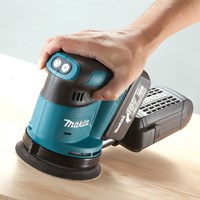Disc Sanders
Filter Options
£0 - £99.99 (33)
£30 - £39.99 (1)
£100 - £199.99 (31)
£100 and over (1)
£200 - £299.99 (6)
£300 - £399.99 (8)
£400 - £499.99 (5)
£600 - £699.99 (4)
Black and Decker (7)
Bosch Professional (10)
DeWalt (2)
Draper (3)
Einhell (13)
Festool (11)
Flex (3)
Yes (13)
Yes (14)
Yes (1)
Yes (1)
Bosch GEX 18V-125 18v Cordless Brushless Random Orbital Disc Sander 125mm
2 types from £174.95
in stock
Bosch GEX 12V-125 12v Cordless Brushless Random Orbital Disc Sander 125mm
2 types from £132.95
in stock
End of page 1 of 2... scroll down for more...
 Loading...
Loading...
End of content
Error - No more pages to load

Disc Sanders Information
Disc sanders use sanding discs which are usually attached to a sanding plate via hook & loop fastening, meaning replacing them is simply a case of ripping the old one off and sticking on a new one. Disc sanders are classed by the diameter of the sanding disc they are designed for (commonly either 125mm or 150mm).Here's our Quick Application Guide:
• Random Orbital Sanders – The Random Orbital sander, Random Orbit Sander or Eccentric Sander is typically regarded as the most essential power sander for general purpose applications. Its sanding plate rotates with an eccentric action which means it doesn’t leave swirl marks behind, and it is powerful enough to remove material fairly quickly when required. The sanding plate on a random orbit sander has integrated dust extraction holes which should be lined up with the holes on compatible sanding discs, enabling dust to be sucked through the machine and into a dust collection canister or attached vacuum.• Disc or Angle Sanders – these machines look like angle grinders with sanding pads attached, and essentially they are, except they have been optimized for sanding instead of grinding and cutting. They are primarily designed for sanding metal and do not have dust extraction systems (which should never be used for metalworking applications).
• Wall and Ceiling Sanders – as the name suggests, these are specialized machines which have been designed to enable the operator to comfortably and easily sand walls and ceilings.






































